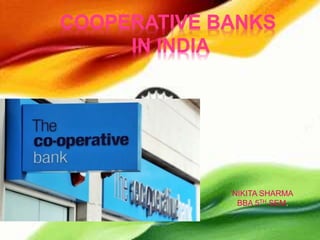
Co operative (2)
- 1. COOPERATIVE BANKS IN INDIA NIKITA SHARMA BBA 5TH SEM.
- 2. ‘A Bank is a financial institution that accepts deposits from the public & creates loans.’ Structure of Banking in India:- RBI COMMERCIAL BANK CO-OPERATIVE BANK
- 3. A co-operative bank is an association of peoples. It is a financial entity which belongs to it’s members, who are at the same time the owners and customers of their bank. Co-operative banks are often created by persons belonging to the same local or professional community or sharing a common interest . Co-operative banks generally provide their members with a wide range of banking and financial services(loans, deposits, banking accounts etc).
- 5. FEATURES OF CO-OPERATIVE BANKS It is a “customer owned banking” . It involves autonomous association of person united voluntarily to meet their common economic, social, cultural needs through a jointly owned & democratically controlled enterprise. Co-operative banks are registered under the Co-operative Societies Act, 1912. It regulated by the RBI under the Banking Regulation Act, 1949 & Banking Laws (application to co-operative societies) Act, 1965. They are organized & managed on the principle of co-operation, self help & mutual help. The major contribution of these banks are mostly in agriculture & Rural sector as where they play the most vital role in Rural financing & Micro financing.
- 6. Co-operative banks are also do banking business in urban and metropolitan areas. Co-operative banks are government supported Financial agency in India. In India, co-operative banks are working for nearly 110 years. Co-operative banks are work on “No Profit & No Loss” Model. Profit maximization is not their goal.
- 7. The major function of co-operative banks are:- a) Mobilization of funds from their members b) Advance loans to the members ,other needy peoples & farmers in the rural areas. The co-operative banks function with the objective of fulfilling the credit requirements and needs of people living in the Rural as well as in the Urban areas. Perform multiple & function at large extent to carryout developments & regulations in the society that strengthen the co-operative movements. It perform all the main Banking functions of Deposits, Mobilization, supply of credit & provision of remittance facilities. It provides limited banking products & are functionally specialists in Agriculture related products.
- 8. Co-operative banks in India finance Rural areas under:- I. Farming cattle II. Milk III. Personal finance Co-operative banks in India finance Urban areas under:- I. Self-employment II. Industries III. Small scale units IV. Home finance V. Consumer finance VI. Personal finance
- 9. Deposits:- a) Saving bank account b) Current account c) Recurring deposits d) Fixed deposits Loans:- a) Loans to salaried employees b) Home needs loans c) Loan to pensioners d) Education & housing loan Services :- clearing Safe deposits lockers ATM Demand draft/ pay order
- 10. History of CO-OPERATIVE BANKS It was the idea of Hermann Schulze(1808-83) and Friedrich Wilhelm Raiffeisen (1818-88) which took shape as co-operative bank of today across the world. In India, towards the end of the 19th century, the problem of rural indebtedness & the consequent conditions of farmers created an environment for the chit fund & co-operative societies they found that it is an attractive mechanism for pooling their meager resources for solving common problems relating to credit, supplies of inputs & marketing of agricultural produce. The experience gained in the working of co-operatives led to the enactment of Co-operative Credit Societies Act,1912. After India attained Independence in August, 1947, co- operatives assumed a great significance in poverty removal & faster Socio-economic growth.
- 11. Types of co- operative banks in India Primary co- operative banks Land development banks Urban co-operative banks Central co- operative banks State co-operative banks
- 12. • Primary co-operative banks:-These are formed at a village level or town level with borrower & non-borrower members residing in one locality. Their operations are restricted to small area. • central co-operative banks:- These banks are operate at a district level having some of the primary credit societies belonging to the same district as their members.
- 13. • state co-operative banks:- These banks are the apex co-operative banks in all states of the country. It acts as a ‘Watchdog’ of the co-operative banking structure in the state. • land development banks:- These banks are meeting the long-term credit requirements of the farmers for developmental purposes. They are situates in the districts & tehsil areas in the state. • urban co-operative banks(ucb’s):- These banks are refers to primary co-operative banks located in urban and semi-urban areas. They essentially lend to small borrowers and businesses.
- 14. Saraswat bank is an ‘Urban co-operative banking institution’ based in Maharashtra, India and operating as a co-operative bank since 14 September 1918. In 1988, the bank was conferred with “Scheduled” status by RBI. The bank is the first co-operative bank to provide merchant banking services. It got a permanent license to deal in Foreign exchange in 1978. It has 283 branches nationwide. ‘Services to the common man ’ has been the motto of Saraswat bank for the last 99 years.